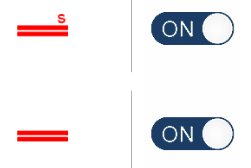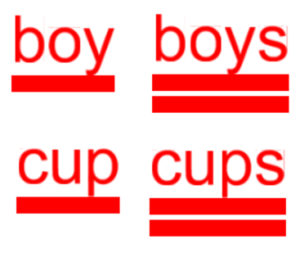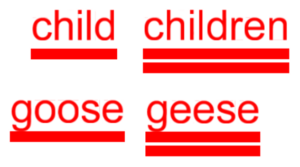NP1 plural -s
You will need:
- red pens and/or SHAPE CODING app
- small toys
- images of singular and plural objects, people, e.g. single cat / group of cats
- ovals, rectangles
App settings: Turn on plurals 
Intervention steps:
- Establish the child understands the concept of one and more than one by asking them to sort toys or images into two groups – single items and more than one.
- Introduce the SHAPE CODING. Make a written list of the single items and underline each word with a single red line. Explain that means “just one”. Do the same for the plural (same sort of) items and underline each plural noun with a double line. Explain this means “more than one”. If the child cannot read, put physical items on a piece of paper and underline single items with a single red line and groups of items with a double red line.

- Practise adding ‘-s‘ to make a set of regular nouns plural, e.g. girl/girls, dog/dogs, bike/bikes. Use single / double red lines to show this. Use a gesture (e.g., fingerspelling or cued articulation) to indicate the addition of the ‘-s‘ verbally. For some children, it may be necessary to highlight the different phonological realisations of the plural -s (voiceless /s/ after a voiceless consonant, voiced /z/ after a voiced consonant or vowel, syllabic /ɪz/ after final -s, -z, -sh, -(t)ch or -(d)ge). Make sure to use words that end in a variety of sounds so that the children learn all three phonological realisations of plural -s. Use games like matching pairs to establish regular plural use at single word level. Say: “One girl / one swan” or “Two girls / two swans” when a pair is found. You could use this PowerPoint to help with the above three steps.
- Teach irregular plural nouns specifically, e.g. child/children, person/people, goose/geese. Again use single / double red lines to show this. Use games like matching pairs to establish irregular plural use at single word level. Say: “one child / one mouse” or “two children / two mice” when a pair is found.

- Monitoring/Error detection. If the child omits the plural ‘-s’, reinforce using the double red line under written words and a gesture (fingerspelling or cued articulation).
If the child adds plural ‘-s’ to an irregular single noun, give feedback and correct by saying, e.g. for ‘mouses’: “Oh, you showed me it was more than one (use red lines to reinforce), but for this one we need to change the word completely. Is it mouses or mice?”If the child adds plural ‘-s’ to an irregular plural noun, give feedback and correct by saying, e.g: “Oh, you remembered to change the word for more than one (use red lines to reinforce) but then you showed me again by adding ‘-s’. You did the job twice! Is it mices or mice?” - Consolidation: At the end of each session, review previous sessions and start to mix up a range of noun types in single words and in different sentence types. At this point, you could add a new target including subject-verb agreement (e.g. is/are, was/were) using the diamond (AG1-4) if appropriate.
- Generalisation: Set up activities where the child has to give a running commentary on a video or while you act out a scene. Name a few of the characters/objects used but not all.
© Moor House School & College

